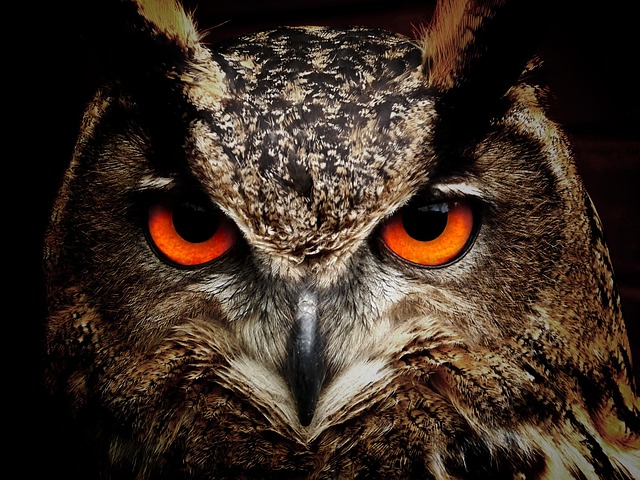Birds have remarkable sensory abilities that allow them to perceive their surroundings in unique ways. One of the ways birds sense their environment is through their keen vision, which enables them to detect movement, colors, and shapes. Additionally, birds rely on their acute hearing to pick up on sounds and calls, helping them identify potential threats or locate prey. Furthermore, birds possess a highly developed sense of touch, particularly in their feet and beaks, which aids them in perceiving textures and temperatures. Lastly, birds also have a well-developed sense of smell, although its importance varies among different species. Overall, birds employ a combination of these senses to sense and interact with their surroundings, including the presence of humans.
Table of Contents
Visual Cues: How Birds Perceive Humans through Sight
Have you ever wondered how birds are able to sense your presence? It’s fascinating to think about how these creatures perceive the world around them. One of the ways birds sense humans is through visual cues. Yes, you heard that right – birds use their keen eyesight to detect our presence and understand our actions.
Birds have excellent vision, much better than humans in many cases. They can see a wide range of colors and have a higher number of color receptors in their eyes. This means that they can perceive colors that are invisible to us. So, when a bird looks at you, it sees a whole spectrum of colors that you can’t even imagine.
But it’s not just the colors that birds notice. They also pay attention to your body language. Birds are experts at reading subtle movements and gestures. They can tell if you’re relaxed or tense, friendly or threatening, just by observing how you carry yourself. So, the next time you’re near a bird, try to be aware of your body language – you might be sending signals without even realizing it!
Another visual cue that birds use to sense humans is eye contact. Just like humans, birds can tell a lot about someone by looking into their eyes. When you make eye contact with a bird, it can interpret your intentions and emotions. If you stare at a bird for too long, it might perceive it as a threat and fly away. On the other hand, if you maintain a gentle gaze, the bird might feel more comfortable and stay nearby.
Birds also pay attention to the size and shape of objects. They have a remarkable ability to judge distances and perceive depth. So, when a bird sees you, it can estimate how far away you are and how big you appear to be. This is why some birds might get scared and fly away if you suddenly approach them – they perceive you as a giant looming over them.
It’s not just your physical appearance that birds notice, but also your clothing. Birds are known to be attracted to bright colors, so if you’re wearing something vibrant, you might catch their attention. On the other hand, if you’re dressed in dull or camouflage clothing, you might blend into the background and go unnoticed. So, if you want to get closer to birds, consider wearing something that stands out.
In addition to visual cues, birds also rely on other senses to perceive humans. They have excellent hearing and can detect even the slightest sounds. So, if you’re trying to approach a bird, be mindful of your footsteps and try to move as quietly as possible. Birds are also sensitive to vibrations, so even the slightest movement can alert them to your presence.
In conclusion, birds have a remarkable ability to sense humans through visual cues. They can perceive colors, read body language, and interpret eye contact. They pay attention to the size, shape, and clothing of objects, and are attracted to bright colors. So, the next time you’re near a bird, remember that it’s not just your physical presence that matters – it’s how you present yourself visually that can make all the difference.
Auditory Perception: Understanding How Birds Hear and Interpret Human Sounds

Have you ever wondered how birds are able to sense your presence? It’s fascinating to think about how these creatures, with their tiny bodies and delicate features, are able to detect and interpret the sounds we make. In this article, we will explore the auditory perception of birds and delve into how they hear and interpret human sounds.
Birds have an incredible sense of hearing, which allows them to detect even the faintest of sounds. Their auditory system is finely tuned to pick up a wide range of frequencies, enabling them to hear sounds that are beyond the range of human hearing. This heightened sense of hearing is crucial for their survival, as it helps them detect potential predators or locate their prey.
One of the key factors that contribute to a bird’s ability to sense human presence is their ability to detect and interpret different frequencies. Birds have a wider range of hearing than humans, which means they can pick up on sounds that are both higher and lower in pitch. This allows them to hear a broader spectrum of sounds, including the high-pitched noises that humans often make without even realizing it.
In addition to their wide range of hearing, birds also have the ability to localize sounds. This means that they can determine the direction from which a sound is coming. This is particularly useful for birds when it comes to detecting potential threats or locating sources of food. By being able to pinpoint the exact location of a sound, birds can quickly assess whether it poses a danger or an opportunity.
But how do birds interpret the sounds they hear? It turns out that birds have a remarkable ability to recognize and remember specific sounds. They can associate certain sounds with specific events or experiences, which helps them make sense of their environment. For example, a bird may learn to associate the sound of a car engine with the presence of humans, and therefore become wary whenever it hears that sound.
Birds also have the ability to distinguish between different types of sounds. They can recognize the sounds made by different species of birds, as well as the sounds made by other animals. This allows them to communicate with each other and establish territories. It also helps them identify potential threats or sources of food.
In conclusion, birds have an incredible auditory perception that allows them to sense and interpret human sounds. Their ability to detect a wide range of frequencies, localize sounds, and recognize and remember specific sounds is truly remarkable. So, the next time you find yourself in the presence of birds, remember that they are not only watching you but also listening to you.
Olfactory Detection: Exploring Birds’ Sense of Smell and Its Role in Sensing Humans
Have you ever wondered how birds are able to sense your presence? It’s not just their keen eyesight or acute hearing that allows them to detect you. Birds actually have a sense of smell, although it may not be as developed as that of mammals. In this article, we will explore the olfactory detection abilities of birds and how it plays a role in sensing humans.
While birds may not rely heavily on their sense of smell like dogs or other mammals do, they still possess olfactory receptors in their nasal cavity. These receptors allow them to detect certain odors in their environment. However, the olfactory system in birds is not as well-developed as in mammals, and they may not be able to detect a wide range of smells.
So, how do birds use their sense of smell to sense humans? One way is through the detection of chemical compounds that are emitted by our bodies. Humans, like all living organisms, release a variety of chemicals through their skin, breath, and even urine. Birds are able to pick up on these chemical signals and use them to identify the presence of humans.
It is believed that birds can detect certain chemical compounds that are unique to humans. For example, studies have shown that birds can detect the scent of human sweat. This is because sweat contains a compound called lactic acid, which birds are able to detect. So, if you’re sweating while walking in the park, don’t be surprised if a bird seems to be keeping a close eye on you!
Birds may also be able to detect other chemical compounds that are associated with humans, such as the scent of certain foods or perfumes. This is why you may sometimes find birds hovering around outdoor dining areas or following people who are wearing strong-smelling perfumes. They are simply using their sense of smell to investigate and find potential sources of food or other interesting scents.
It’s important to note that not all bird species have the same olfactory detection abilities. Some birds, such as vultures and kiwis, have a highly developed sense of smell and rely on it heavily for finding food. On the other hand, birds like pigeons and chickens have a less developed sense of smell and rely more on their vision and hearing.
In conclusion, while birds may not have the same level of olfactory detection as mammals, they still possess the ability to sense certain smells, including those emitted by humans. By detecting chemical compounds in our bodies, birds are able to identify our presence and even investigate interesting scents. So, the next time you’re out in nature and notice a bird acting curious around you, remember that it may be using its sense of smell to sense your presence.
Behavioral Responses: Unveiling Birds’ Reactions and Behaviors towards Human Presence
Have you ever wondered how birds seem to know when you’re nearby? It’s as if they have a sixth sense that alerts them to your presence. Well, the truth is, birds do have a remarkable ability to sense humans and react accordingly. In this article, we will explore the fascinating world of bird behavior and uncover the secrets behind their reactions to our presence.
Birds have evolved over millions of years to be highly perceptive creatures. They rely on their senses to navigate their surroundings and detect potential threats. One of the ways they sense humans is through their keen eyesight. Birds have excellent vision, allowing them to spot even the slightest movement from a distance. So, when you approach their territory, they can quickly detect your presence and become alert.
But it’s not just their eyes that help birds sense you. They also have a remarkable sense of hearing. Birds can pick up on sounds that are beyond our range of perception. They can hear the rustling of leaves or the snapping of twigs as you walk through their habitat. This heightened sense of hearing allows them to be aware of your presence even before they see you.
In addition to their visual and auditory senses, birds also rely on their sense of smell. While not as developed as in mammals, birds can still detect certain scents in the air. They use this sense to identify potential predators or sources of food. So, when you’re nearby, birds may catch a whiff of your scent, further alerting them to your presence.
Once birds sense your presence, they exhibit a range of behaviors that can vary depending on the species and the individual bird. Some birds may become more cautious and vigilant, keeping a close eye on you while maintaining a safe distance. Others may become defensive and aggressive, especially if they perceive you as a threat to their nest or offspring.
On the other hand, some birds may not be bothered by your presence at all. These birds have become habituated to human activity and have learned that humans pose no immediate danger. They may continue their activities, such as foraging for food or singing their melodious songs, even in close proximity to you.
It’s important to note that birds’ reactions to humans can also be influenced by their previous experiences. If a bird has had negative encounters with humans in the past, it may be more wary and skittish around them. Conversely, if a bird has had positive experiences, such as being fed by humans, it may be more tolerant and accepting of their presence.
So, the next time you find yourself in the presence of birds, take a moment to observe their behavior. Notice how they react to your presence and how they adapt to your movements. It’s a fascinating glimpse into the intricate world of bird behavior and a reminder of the incredible abilities these creatures possess.
In conclusion, birds have a remarkable ability to sense humans and react accordingly. Through their keen eyesight, acute hearing, and limited sense of smell, they can detect our presence even before we’re aware of theirs. Their reactions can range from cautious vigilance to defensive aggression or complete indifference. Understanding and respecting these behaviors can enhance our appreciation for the natural world and the incredible creatures that inhabit it.
Conclusion
In conclusion, birds sense humans through a combination of visual, auditory, and olfactory cues. They have well-developed eyesight and can detect movement and colors, allowing them to perceive humans from a distance. Birds also have acute hearing and can pick up on human voices and other sounds. Additionally, birds have a keen sense of smell and can detect human scents, which may influence their behavior and response. Overall, birds rely on their sensory abilities to sense and respond to the presence of humans in their environment.
For licensing reasons, we must provide the following notice: This content was created in part with the help of an AI.


